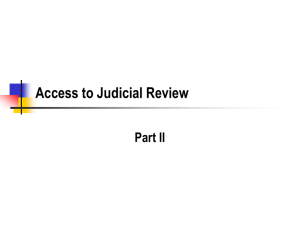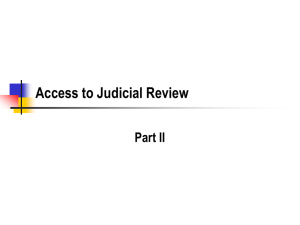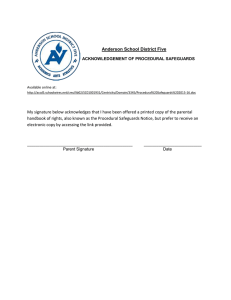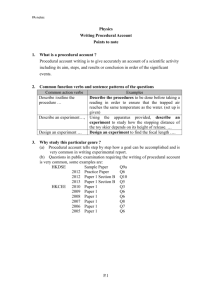Access to Judicial Review Part II
advertisement
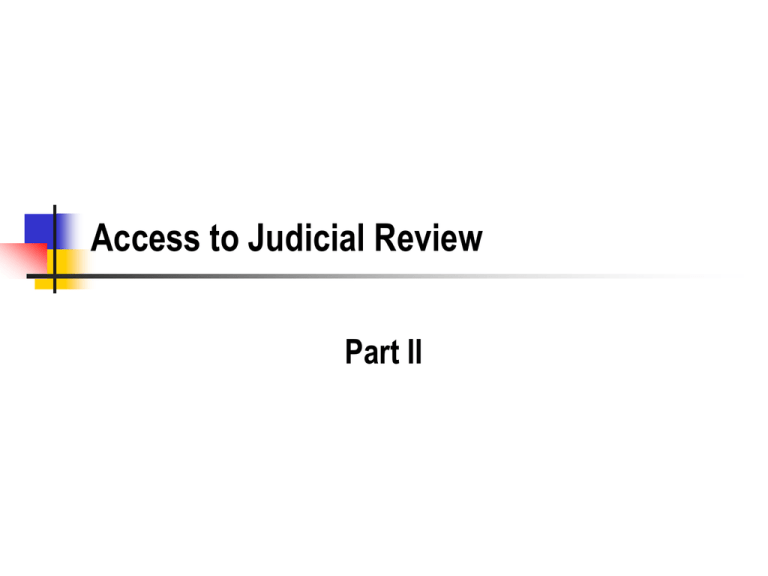
Access to Judicial Review Part II Procedural Injury In Lujan, the procedural violation was the failure of the agency to do an inter-agency consultation. Was the public allowed to participate in this? Why does this keep DOW from being able to state an injury? Procedural injuries still require the nexus to the activity. How can a procedural violation cause substantive injury? What was the injury in the procedural due process claims we talked about in Chapter 4? 2 Example – The Dredge Permit The Corps does not do the required public hearing before issuing a dredge and fill permit. You are counsel for DOW and you claim your injury is the failure to be able to comment on the permit. Is this enough to get standing? Does the denial of the right to comment constitute injury? What about a landowner whose land would be affected by the change in runoff? 3 Informational Injury FOIA provides that anyone may request and receive non-privileges government documents. What is the injury if the agency refuses to provide a document that is available under FOIA? Why does this depend on the statutory policy of the FOIA? 4 Example - FEC Classification Decision FEC does not classify an organization as one that must make public reports of its finances, which are then published by the FEC. Does a plaintiff who wants info on the group have standing to contest the classification? How did the Court use the purpose for collecting the information to support the plaintiff's standing claim? "Here, Congress, by passing the Act with the disclosure requirement, had deemed the information to be important to inform voters.“ Federal Election Commn. v. Akins, 524 U.S. 11 (1998) 5 Lujan Revisited as an Informational Injury The Endangered Species Act requires an agency to get a Biological Opinion before issuing a permit. Lujan said that failing to get the opinion was not a procedural injury. How could you argue, using the FEC example, that failure to obtain the Biological Opinion, which would be a public document, is an informational injury? The ESA allows citizens to sue if it is violated. Assume your group publishes the opinions. 6 Injury to All The usual remedy for “injury to all” cases is legislative or executive, not judicial. Taxpayers, for example, have very limited standing as such. In the FEC case, everyone was denied the information about the contributions. There was standing because Congress said in the enabling legislations that ‘‘any party aggrieved’’ by a Commission denial of its complaint could obtain judicial review of the denial. In the absence of specific statutory authorization, most injury to all cases will not get standing. 7 Causation for Standing 8 Procedural Violations and Causation: Agency Fails to do an EIS for a Dam How does failing to do the EIS make the final agency action – building the dam – illegal? Do you have to show that that they done the EIS, that the permit for the dam would not have been issued? Is this partially driven by the nature of the EIS, i.e., that it is only informational and does not directly drive decisionmaking? Why does this make it difficult to show that an EIS would affect the outcome of agency decisiomaking? 9 Confusion with Harmless Error 5 U.S.C. § 706 (Civil procedure) “In making the foregoing determinations, the court shall review the whole record or those parts of it cited by a party, and due account shall be taken of the rule of prejudicial error.” Some courts have required plaintiff to show it is substantially probable that the procedural breach will cause the injury Is this a proper standard for a procedural violation, such as failing to do an EIS? Must the plaintiff show that it is more than theoretically possible for the violation to affect the outcome? How could the agency show that the EIS could not have altered the decisionmaking? 10 Does the Remedy Help Your Client? Simon v. Eastern Ky. Welfare Rights Organization, 426 U.S. 26 (1976) Group challenged the tax exemption for a hospital, saying it did not deliver enough charity care Why is the plaintiff asking for this remedy? Would denying the exemption increase charity care? What if plaintiffs could show that the exemption is so valuable that hospitals always cave in before losing it? 11 What type of Causation? Must the government’s violation directly affect plaintiff? Does the EPA’s failure to regulate greenhouse gasses directly affect MA’s coast line? What directly affects the coast? Does the EPA’s regulatory failure contribute to the climate change that affects the ocean? 12 Redressability You have to be able to show that the remedy you seek from the court would address your problem If you have stated a concrete claim for injury to your client, you probably have also met this standard The agency must have the power to grant your remedy The remedy must address your client's problem 13 Procedural Violations and Redressability Assume you have stated a real procedural injury Is there still a redressability problem because the plaintiff cannot show that fixing the violation would result in a favorable result? In Lujan v. Defenders of Wildlife, the Court said, “[t]he person who has been accorded a procedural right to protect his concrete interests can assert that right without meeting all the normal standards for redressability and immediacy." Do you still have to show a theoretical effect if the procedure is fixed? What if Congress has directed the agency do the project (without waiving environmental regs) and the agency claims it will do it no matter what the EIS says? 14 Representational Standing When can associations bring actions on behalf of their members? At least one member must have standing It must fit the organizational mission The remedy must not require the participation of individual plaintiffs, beyond the standing analysis Injunctive relief or declaratory judgments Why is representational standing important for environmental and poverty action groups Why might businesses with money still need it? 15
